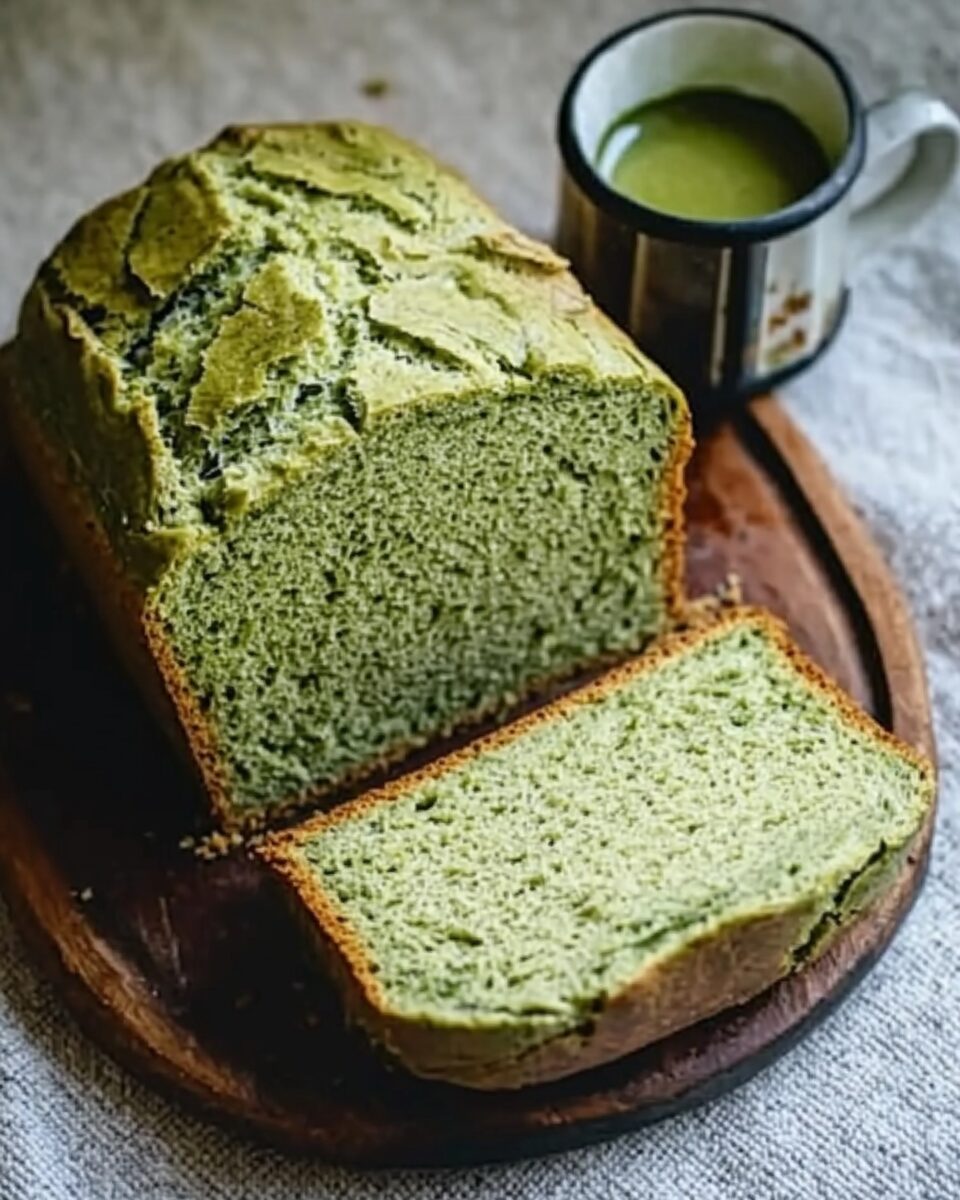Matcha Green Tea Bread is a delightful fusion of traditional bread-making and the unique, earthy flavor of matcha powder. This soft and fluffy loaf is perfect for breakfast or as a snack, offering a subtle sweetness and a vibrant green hue that makes it both tasty and visually appealing.
Full Recipe:
Ingredients
- 1/2 cup warm water
- 1/3 cup white sugar
- 2 teaspoons active dry yeast
- 2 1/2 cups bread flour
- 1 tablespoon matcha green tea powder
- 1 tablespoon dry milk powder
- 1 teaspoon salt
- 1 egg
- 2 tablespoons butter, softened
- 1/2 cup warm milk
Directions
-
Activate the Yeast: In a bowl, combine warm water and sugar, stirring until dissolved. Sprinkle the yeast over the water and let it sit until frothy, about 5 minutes.
-
Prepare Dry Ingredients: In a large mixing bowl, whisk together bread flour, matcha powder, dry milk powder, and salt.
-
Combine Wet and Dry Ingredients: To the dry mixture, add the activated yeast, egg, softened butter, and warm milk. Mix until a dough forms.
-
Knead the Dough: Transfer the dough to a lightly floured surface and knead for about 10 minutes until smooth and elastic.
-
First Rise: Place the dough in a lightly oiled bowl, cover with a damp cloth, and let it rise in a warm place until doubled in size, approximately 1 hour.
-
Shape the Dough: Punch down the risen dough and transfer it to a work surface. Roll it into a large rectangle slightly wider than the length of your loaf pan. Starting from the shorter end, roll the dough tightly into a log, pinching the seam to seal.
-
Second Rise: Place the rolled dough seam-side down into a greased loaf pan. Cover with plastic wrap and let it rise until it fills 80% of the pan, about 45 to 60 minutes.
-
Preheat Oven: Preheat your oven to 375°F (190°C).
-
Bake: Bake the loaf in the preheated oven until golden brown on top, about 30 to 35 minutes.
-
Cool: Immediately remove the bread from the pan and transfer it to a wire rack to cool completely before slicing, approximately 30 minutes.
Nutritional Facts (per serving)
- Calories: 160
- Total Fat: 4g
- Saturated Fat: 2g
- Cholesterol: 31mg
- Sodium: 236mg
- Total Carbohydrates: 26g
- Dietary Fiber: 1g
- Sugars: 4g
- Protein: 5g
The History and Popularity of Matcha in Baking
Matcha, a finely ground green tea powder, has been an integral part of Japanese culture for centuries. Traditionally used in tea ceremonies, matcha is now widely incorporated into various foods and beverages, including lattes, ice creams, cakes, and bread. The use of matcha in baking has gained immense popularity due to its unique umami flavor and numerous health benefits.
Matcha bread is a modern twist on traditional baked goods, appealing to those who enjoy experimenting with flavors while maintaining a healthy lifestyle. Bakeries worldwide, particularly in Japan, Korea, and other Asian countries, have introduced matcha-infused bread as a staple item, and it has gradually made its way into Western baking traditions as well.
What Makes Matcha Green Tea Bread Special?
Matcha Green Tea Bread stands out for its distinct characteristics, both in appearance and taste. The bright green hue, achieved naturally from matcha powder, makes it visually appealing. Unlike artificial food coloring, matcha provides a natural vibrancy while contributing to the overall nutritional profile of the bread.
The flavor profile of matcha bread is a delicate balance of sweetness and slight bitterness, offering a depth that traditional white or wheat bread lacks. This complexity makes it a versatile option, pairing well with both sweet and savory toppings.
Health Benefits of Matcha Green Tea Bread
One of the main reasons matcha bread has gained popularity is due to the health benefits associated with matcha powder. Here are some of the key advantages of consuming matcha-infused bread:
- Rich in Antioxidants: Matcha is packed with catechins, a type of antioxidant that helps fight free radicals in the body. These antioxidants contribute to overall wellness and may reduce the risk of chronic diseases.
- Boosts Metabolism: Matcha contains a natural compound called EGCG (epigallocatechin gallate), which has been shown to enhance metabolism and promote fat oxidation.
- Provides Sustained Energy: Unlike coffee, which gives a quick energy spike followed by a crash, matcha contains L-theanine, an amino acid that promotes calmness while providing long-lasting energy.
- Supports Heart Health: Studies suggest that green tea consumption can help lower cholesterol levels and reduce the risk of heart disease.
- Aids in Detoxification: Matcha is rich in chlorophyll, a natural detoxifier that helps cleanse the body of toxins.
- Improves Focus and Mental Clarity: The combination of caffeine and L-theanine in matcha enhances cognitive function, making it an excellent choice for those needing a mental boost.
By incorporating matcha into bread, you get the benefits of both green tea and whole grains (if using whole wheat flour), making it a nutritious addition to your diet.
How to Enjoy Matcha Green Tea Bread
Matcha Green Tea Bread is incredibly versatile and can be enjoyed in various ways. Some popular ways to serve this delicious bread include:
- Toasted with Butter or Honey: A simple yet satisfying way to enjoy matcha bread is by toasting it lightly and spreading a layer of butter or drizzling some honey for added sweetness.
- With Cream Cheese or Nut Butter: The creamy texture of cream cheese or nut butter complements the earthy tones of matcha, making for a delicious spread.
- As a Base for French Toast: Transform matcha bread into a delightful breakfast dish by using it for French toast. The green color adds an appealing aesthetic to the dish.
- With Ice Cream or Whipped Cream: A slice of matcha bread pairs wonderfully with vanilla ice cream or a dollop of whipped cream for a dessert-like experience.
- In Sandwiches: Matcha bread works well for both sweet and savory sandwiches. Try using it for a peanut butter and banana sandwich or pairing it with ham and cheese for an interesting flavor contrast.
Baking Tips for the Perfect Matcha Green Tea Bread
To achieve the best results when baking matcha bread, here are a few key tips to keep in mind:
- Use High-Quality Matcha: The quality of matcha significantly affects the final taste and color of the bread. Use high-grade or ceremonial-grade matcha for the best results.
- Balance the Sweetness: Since matcha has a naturally bitter taste, adjusting the amount of sugar in the dough is important to ensure a pleasant balance of flavors.
- Control the Baking Time: Overbaking can lead to a dry texture, while underbaking may result in a doughy consistency. Monitor the baking time closely to achieve the perfect softness.
- Knead the Dough Well: Proper kneading ensures that the bread develops a good structure and elasticity, leading to a fluffy and airy texture.
- Let the Dough Rise Properly: Allowing the dough to rise adequately before baking ensures a light and fluffy loaf. Insufficient rising time can result in dense bread.
The Cultural Influence of Matcha in Modern Cuisine
Matcha has evolved from being a traditional tea into a global culinary trend. It is now a staple ingredient in many modern recipes, including pastries, smoothies, and even savory dishes. Matcha bread represents the perfect blend of tradition and innovation, appealing to both classic tea lovers and contemporary food enthusiasts.
The growing interest in Asian flavors in Western countries has contributed to the increasing popularity of matcha-infused baked goods. Many cafes and bakeries now feature matcha bread and pastries on their menus, catering to the demand for unique and health-conscious options.
Conclusion
Matcha Green Tea Bread is more than just a visually striking baked good—it is a fusion of flavor, tradition, and health benefits. Whether you are a seasoned baker or trying matcha bread for the first time, this delightful treat is worth exploring. Its versatility allows for various serving options, and its nutritional profile makes it a great addition to any diet.






